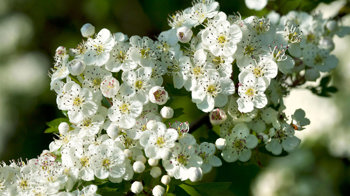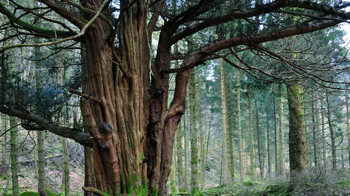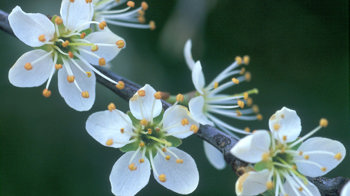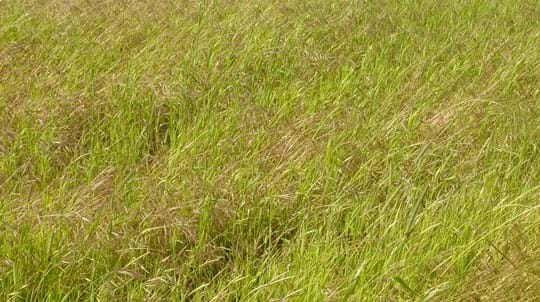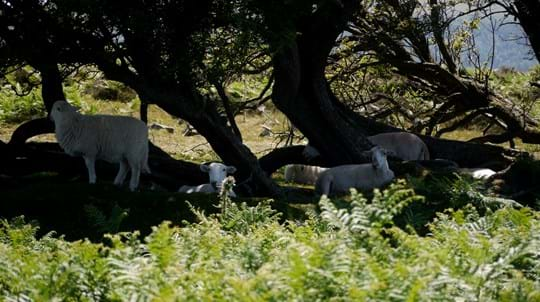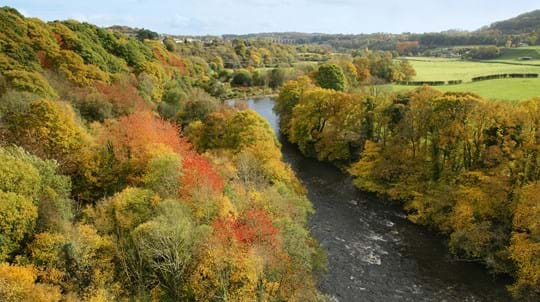
Pen y Coed
Llangollen

Woodland Trust wood
27.95 ha (69.06 acres)
SJ227413
Explorer 256
OS Landranger 117
This attractive wood offers a mix of ancient semi-natural woodland containing pockets of beautiful seasonal flowers such as bluebell and wood anemone; as well as a conifer plantation. The site was heavily planted with conifers in the mid-20th century, but these are being gradually thinned, allowing native broadleaf species to flourish and young broadleaf saplings to grow.
Enjoy great views of the Dee Valley from the numerous paths, including two waymarked routes. While some archaeological features are easier to find than others, they leave clues to the past land use.
Features
- Parking nearby
- Public access
- Spring flowers
- Waymarked walk
- Broadleaved woodland
How to get to Pen y Coed
Pen y Coed lies on its own prominent hill to the east of the picturesque Welsh town of Llangollen in Denbighshire. The 28-hectare (69.2-acre) woodland is a distinctive landscape feature, clearly visible from the village and the Eglwyseg escarpment and hills to the south.
From Wrexham, take the A483 heading south. After passing junction 1, leave the A483 at the next roundabout, taking the A5 to Llangollen. On entering Llangollen, the A5 becomes Queen Street. Continue along Queen Street until you reach the Star Inn on your right.
Turn left opposite the inn onto Brook Street and park in the small public car park immediately on the left. Continue on foot along Brook Street and turn left for footpaths that lead up the hill.
The last 183 metres (200 yards) to the wood involve a steep uphill climb before you cross a grazed field and access the wood via a kissing gate.
The nearest train station is Chirk, just over 7km (6 miles) away.
Visit National Rail for more information.
The nearest bus stop is located on Market Street in Llangollen town centre.
Visit Traveline for more information.
Facilities and access
There are five public access points into the site, the majority from Brook Street. The closest and most frequently used by visitors has a kissing gate with a short flight of steps to join a main path into the wood. The entrance closest to the highway has an access point suitable for all abilities.
A public footpath runs inside the north-eastern boundary of the wood and follows an old track for the most part. The internal paths and tracks are unsurfaced and moderate to steeply sloping in parts. The path surfaces, particularly on the eastern side of the hill, are loose shale and can be slippery in both wet and dry conditions. The red circular route is 2km (1.2 miles/40 mins). The blue extension loop is 1km (0.6 miles/20 mins)
The local public footpath network links Pen Y Coed with The Avenue (another Woodland Trust wood) to form a popular circular walk – the red waymarked trail.
There is a small public car park on Brook Street near the wood, which holds around 10 cars, as well as roadside parking close to the site.
The nearest public toilets are at the main public car park in Market Street, Llangollen. There are also disabled facilities accessible with a RADAR key here.
Wildlife and habitats
Animals
Pen y Coed is home to a wealth of birds, including sparrowhawk, jay, wren and blue tit. Listen out for the sound of the great spotted woodpecker hammering away here, and keep an eye out for roaming mammals such as badger and fox.
Trees, plants and fungi
Pen y Coed is a diverse woodland. The mixed canopy bursts into colour in the autumn and the bluebells light up the woodland floor in spring.
Habitats
Pen y Coed is an ancient woodland, a large part of Pen y Coed was replanted in the mid-20th century with dense stands of conifer. However, the woodland is responding to restoration well and the original areas of semi-natural woodland are expanding. The mix of broadleaf trees includes ash, sycamore, sessile oak, wild cherry and sliver birch together with shrubs such as rowan, hazel, hawthorn, yew and holly.
History of Pen y Coed
The southern half of the site was probably owned and managed by the Cistercian abbey of Valle Crucis which was founded in 1201. You can still see old coppice stools on the southern slopes which hint at the historic use of the woodland.
The northern half of the wood was cleared for agricultural use in the 17th century. This period in history has left behind impressive field boundary walls, large stone gateposts and signs of historical trackways. The stone used is thought to be dug from quarries in the wood.
Much of Pen y Coed was replanted with conifers in the mid-20th century, and since its acquisition in 1995, which was made possible due to a successful local fundraising campaign. We have been restoring these areas back to broadleaved woodland.
Things to do at Pen y Coed
Walking
There are a range of walks to be enjoyed at Pen y Coed. Pick up one of the site leaflets from the tourist office in Llangollen and head out to explore the woods!

Visiting woods
Walking dogs in our woods
Dogs are welcome for walkies in our woods. Take a look at our tips and guidelines for ensuring we keep our woods safe and special for dogs and wildlife.

Visiting woods
Events
Discover events at our woods and the festivals and fairs you can find us at soon.

Visiting woods
Things to do in the woods
Go on an adventure. Get closer to nature. Uncover history. Discover ways to explore the UK's woods whatever the season.






















